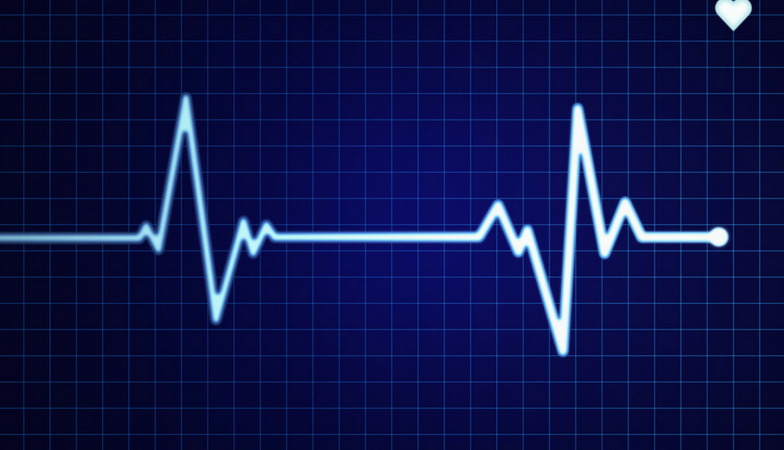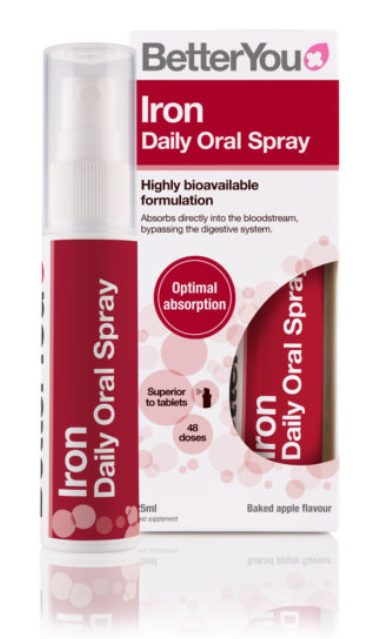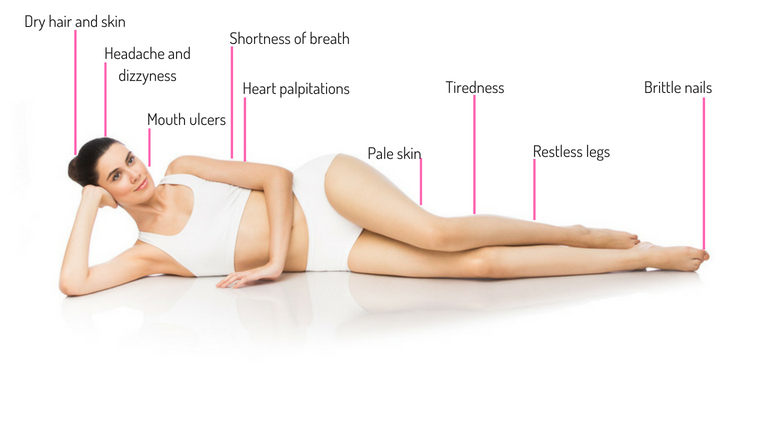The percentage of women with anaemia has risen, according to a new report. So what are the key signs of iron deficiency and what you can do to help?
A new global report is warning that anaemia among women of reproductive age has increased from 14 per cent in 2016 to 15.3 per cent in 2016 (?) and a third (32.8 per cent) of reproductive-age women globally are anaemic.
Anaemia is a condition caused by a lack of iron. Iron deficiency is often caused by factors such as blood loss or pregnancy. Now scientists believe that iron deficiency could be to blame for women’s mood swings during their time of the month, rather than their hormones as is commonly thought.
Researchers at Nicolaus Copernicus University say that a drop in iron can worsen women’s cognitive performance and endurance causing them to become moody and at a higher risk of depression. The lack of this vital nutrient, which is found in leafy green vegetables such as spinach kale and broccoli, occurs due to blood loss and causes the body’s brain and central nervous system to slow down.
Iron deficiency (ID) is the most common nutritional deficiency affecting more than two billion people around the world.
According to the National Heart, Lung, and Blood Institute, an estimated 20 per cent of women at childbearing age have iron deficiency anemia.
It’s staggering to imagine that, in an age where we think we’re so savvy about food, there is still a nutrient that 80 per cent of the global population, most of them women, are not getting in adequate levels.
But according to the World Health Organisation (WHO) some eight in ten people worldwide are deficient in iron.
In the UK alone, iron deficiency is rampant and according to the latest figures from the Scientific Advisory Committee on Nutrition Iron and Health review, those most at risk include women aged 35-49 years, girls aged 15-18, toddlers aged 1-2 and men aged 65 and over.
What’s more, a 2016 study in respected medical journal The Lancet suggests a third of the population have anaemia, so their iron deficiency is at critically low levels.
But one of the reasons this nutritional deficiency is so widespread – despite it being relatively easy to treat – is because doctors often miss its common symptoms, say experts.
Those most at risk of deficiency include women aged 35-49 and girls aged 15-18
What’s causing this widespread iron deficiency?
‘The soaring rise in popularity of vegan and plant-based diets is one of the key factors behind why more and more people are finding themselves nutrient deficient,’ says leading nutritionist Greg Weatherhead.
‘While it does have its advantages such as lowering blood pressure and cholesterol, removing entire food groups from your diet also removes essential nutrients.
‘Fitness and lifestyle influencers have responsibility here as they encourage a wide variety of people to modify their diets to follow a healthier lifestyle,’ says Weatherhead.
‘Those that promote a vegan or vegetarian diet also have an obligation to highlight the importance of substitution rather than simply eliminating important food groups.
‘This is because meat is the only natural source of haem iron, which is considerably more absorbable than the non-haem iron found in plant sources.
‘What’s more, the amount of processed foods we consume means that the number of vitamins and minerals under-represented or omitted from our diet is on the increase,’ says Weatherhead.
How much iron do we need a day?
The British Dietetic Association’s recommended dietary allowance (RDA) of iron for women aged 19-50 years is 18mg. What does that mean in food terms?
‘This is the equivalent of over 1.6kg of turkey, 24 eggs or 1.2kg of kale per day,’ says Weatherhead. This RDA for women increases to 27mg during pregnancy highlighting the vast increase in iron requirements during this time.
‘For men, men aged 19-50 years, the recommendation is 8mg daily which is almost 800g of turkey, approximately 11 eggs or just over 530g of kale per day’.
Symptoms of iron deficiency
It doesn’t help that doctors often miss the signs of iron deficiency.
‘Iron is essential to a vast number of processes within the body, meaning that the symptoms of deficiency can manifest themselves in number of different ways,’ Weatherhead explains.
Lack of energy, pallor and some mood symptoms might seem like obvious signs, but some are far less so.
One of the strangest symptoms of iron deficiency is the compulsion to eat non-food items, ranging from ice cubes to dirt and plaster, a condition called pica. It’s not understood (funny that) how iron deficiency causes this behaviour.
GPs can test iron levels whenever they deem necessary through a simple blood test.
So, what are the most common symptoms of iron deficiency to watch for and report to your doctor?

You’re always exhausted
This is one of the most common signs of iron deficiency because iron is responsible for the transportation of oxygen to all body tissues.
Too little iron in the body deprives the tissues of energy, leaving you exhausted as your body tries to take energy from wherever it can.
In fact, research published in the Danish Medical Journal in 2014 suggested that of patients that were critically iron deficient, almost half experienced physical tiredness as their key symptom.
The good news was that the same research found that supplementation with iron (see below) was significantly effective in relieving symptoms.
Shortness of breath
Those low haemoglobin levels also mean the body can’t transport enough oxygen to the muscles and tissues effectively and this can manifest as shortness of breath, during exercise or even everyday activities such as climbing stairs.
In fact, according to the NHS website, shortness of breath, along with pale skin, tiredness and heart palpitation are among the most common symptoms of iron deficiency.

You have pale skin (or a pale tongue)
Pale skin is quite typically associated with low iron levels and indeed anaemia. But even if your skin isn’t pale, there is another key check you can make – pull down your inner eyelid and take a look in the mirror.
‘Paleness in general, whether it’s the skin, nails, eyelids or any other area can indicate low iron levels,’ says Greg Weatherhead. ‘This is due to low levels of haemoglobin which carries oxygen from the lungs, which helps to give the blood its red colour.’
Iron is an essential part of haemoglobin which carries oxygen from the lungs, transporting it throughout the body. Without enough iron, the body can’t make enough healthy oxygen-carrying red blood cells, leading to that tell-tale pallor.
If you’re still unsure, check out your tongue. A study published in 2010 in the journal PLOS One found that tongue pallor was the most common indicator of iron deficiency anaemia, even more than facial pallor.
Restless Legs
Restless Leg Syndrome (RLS) is an overwhelming desire to move the legs and it’s something that usually gets worse in the evenings and at night. It can cause an unpleasant crawling sensation in the feet, calves and thighs, and occasionally the arms are affected too.
While studies have confirmed that those with RLS often have difficulty absorbing the iron in their diets, a double-blind placebo-controlled clinical study published in 2009 in the journal Sleep Medicine found those with RLS who took iron orally for 12 weeks had significant improvements in their symptoms.

Headache and dizziness
The lack of haemoglobin in the blood that iron deficiency causes means not enough oxygen reaches the brain, causing its blood vessels to swell and create pressure, resulting in pain, explains Greg Weatherhead.
And, if you get menstrual migraines or headaches, research from 2010 suggests you might need to get your iron levels checked.
The study, from University Hospital, Zagreb, found that menstrual headaches and migraines were a common symptom in women who also had iron deficiency – imagine if getting rid of them could be as easy as taking iron?
Low iron levels may also have an impact on our mental health, asserts Greg Weatherhead. ‘Anxiety, panic attacks, mood swings, depression and a lack of concentration can all be symptoms of iron deficiency too.’
Brittle nails
‘Low levels of iron can cause nails to become more brittle,’ says Greg Weatherhead. ‘This is usually accompanied by other symptoms such as fatigue and pale skin.’
‘The more serious iron deficiency anaemia has a more significant impact on our nails with them becoming concaved and looking as though they scoop away from the finger, like a spoon – this is a tell-tale sign of iron deficiency,’ says Weatherhead.

Heart palpitations
In cases of iron deficiency, the heart needs to work harder to transport oxygen around the body and this can result in heart palpitations – something that needs to be looked at by a doctor.
‘This can lead to irregular or fast heartbeats and even heart murmurs, an enlarged heart or in extreme cases heart failure,’ says Greg Weatherhead.
Swelling and soreness in the mouth
‘A sore, swollen or strangely smooth tongue can be a sign of iron deficiency anaemia,’ says Weatherhead. Cracks on the corners of the mouth and ulcers can also be a sign.’
Inflammation of the tongue (known as glossitis) can be caused by iron deficiency. Iron plays a crucial role in regulating cell growth and the production of red blood cells which carry oxygen around the body into tissues and muscles.
Low iron in the blood can result in a low level of a protein called myoglobin – this protein is responsible for carrying the oxygen to muscles including the tongue.
Due to a lack of oxygen, cells struggle to maintain their function, and this can cause the smooth appearance of the tongue as the papillae don’t develop as new cells regenerate.

Dry hair and skin
As skin and hair receive less oxygen from the blood because of iron deficiency, they can become dry and damaged, says Weatherhead.
In more severe cases this can result in hair loss, which affects an estimated eight million women in the UK.

What’s the deal with iron supplements?
If you find iron supplements confusing you’re not alone – you may like us, have heard about absorption levels varying and that they can make you constipated.
‘There are two categories of iron supplements, those which contain the ferrous form of iron and those which contain the ferric form of iron,’ says Weatherhead.
Even more confused? Don’t be.
Ferric iron is the oxidised form of iron which makes it less reactive. ‘This means it’s less likely than ferrous iron to act as a free radical and damage the cells once within the body,’ says Weatherhead.
One specific form of ferric iron known as ferric EDTA has been the subject of a large clinical trial demonstrating its superiority over other forms.
The trial, published in 2014 in the Tanzanian Journal of Health Research, showed how a 5mg supplement of this form of iron provided the same increase in haemoglobin concentration as a 10mg ferrous iron supplement.
‘That meant this form of iron reduced the oxidative stress imposed on the body by the more reactive ferrous forms of iron,’ says Weatherhead.
What about side effects?
You’ve probably heard about how many iron supplements can leave you constipated, which is not a great trade-off.
‘Any iron supplement which travels through the digestive system will have gastrointestinal side effects such as abdominal discomfort, nausea, vomiting and constipation’ says Weatherhead.
Any iron supplement which travels through the digestive system will have gastrointestinal side effects
‘The reason for this’, he explains, ‘is that iron is hard on the digestive tract and only a fraction of the iron consumed will be absorbed, leaving the remaining iron to sit in the gut and cause irritation.
‘Ferrous forms of iron are also known to cause more side effects than the ferric forms of this compound’.
Which form of iron is best?
Aside from tablet forms, you can also opt for iron liquids which are available from health food stores and pharmacies.
But a new cheek spray form of iron could be the most absorbable form of iron commercially available yet.
‘An intra-oral spray such as BetterYou’s Daily Iron Oral Spray (£9.95 from Healthista Shop) is the most effective method of delivering iron as it hits the bloodstream directly rather than relying on primary processing by the digestive system,’ says Weatherhead.
In fact, a study on vitamin D published in Nutrition Journal showed that vitamin absorption via and oral spray is 2.5 times more effective than vitamin capsules. Plus, an oral spray is fast absorbing and not reliant on food or water to take.
Related Healthista content
5 symptoms of vitamin D deficiency that are ruining your wellbeing
6 signs of zinc deficiency that ruin your looks
9 ways to help your body fight the effects of pollution
Is magnesium deficiency causing your insomnia?
Like this article? Sign up to our newsletter to get more articles like this delivered straight to your inbox.





















































